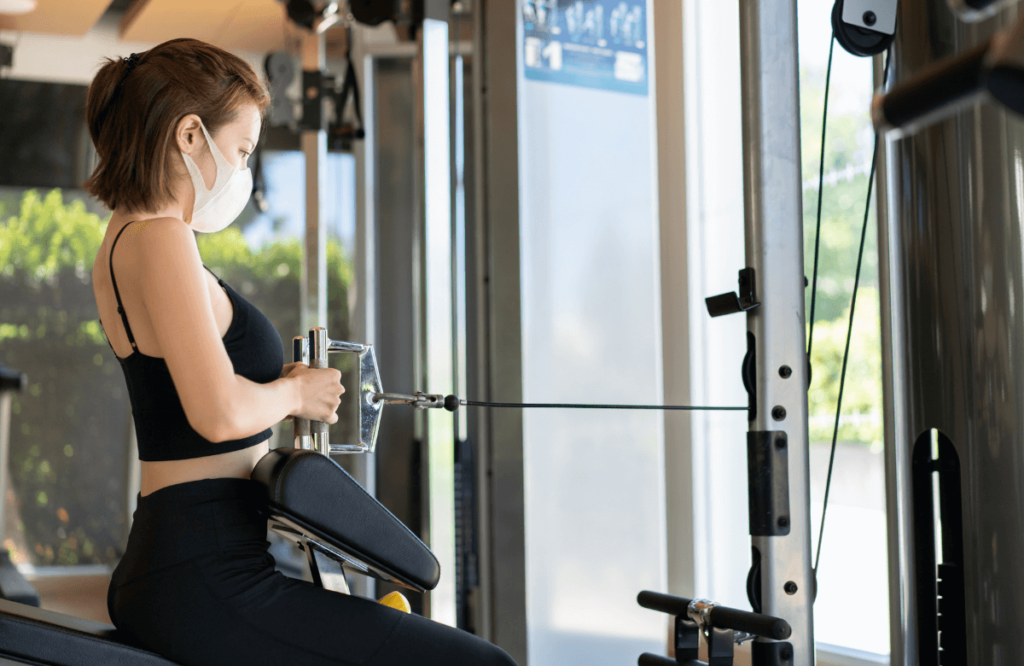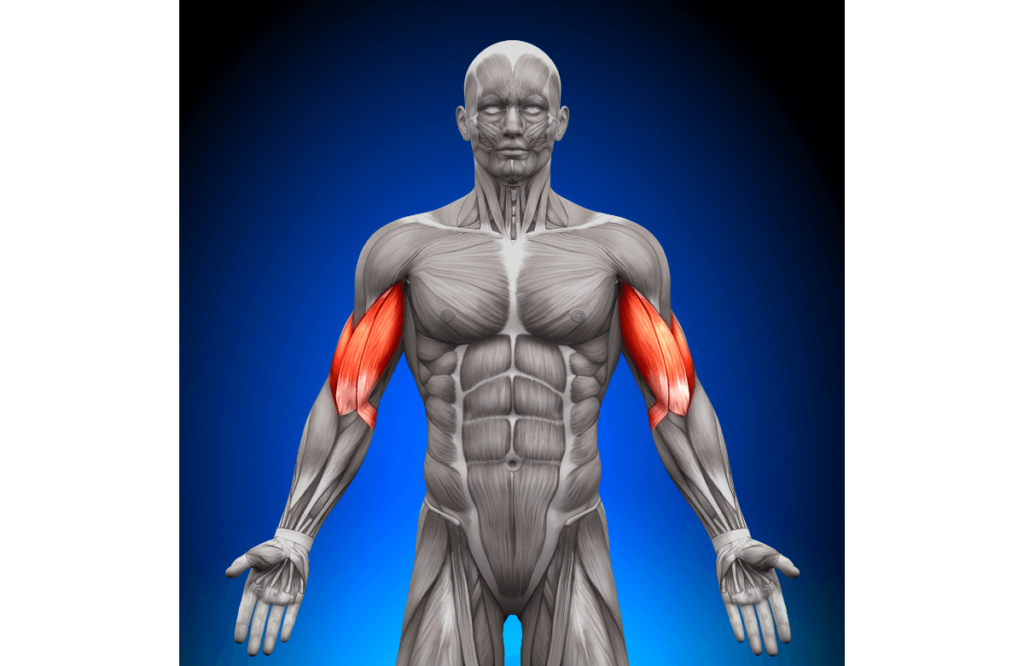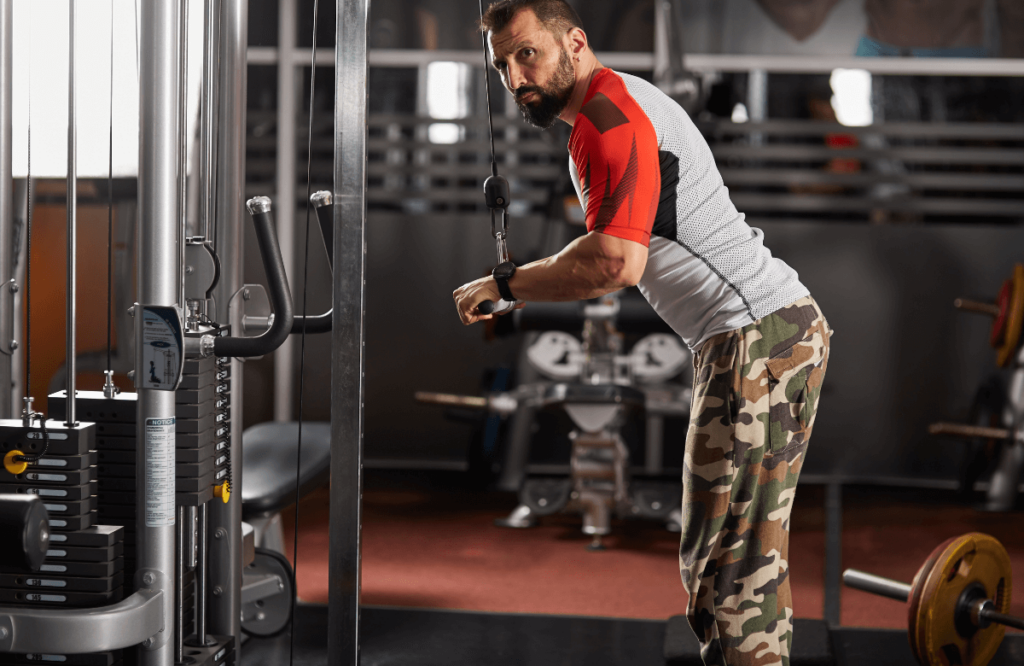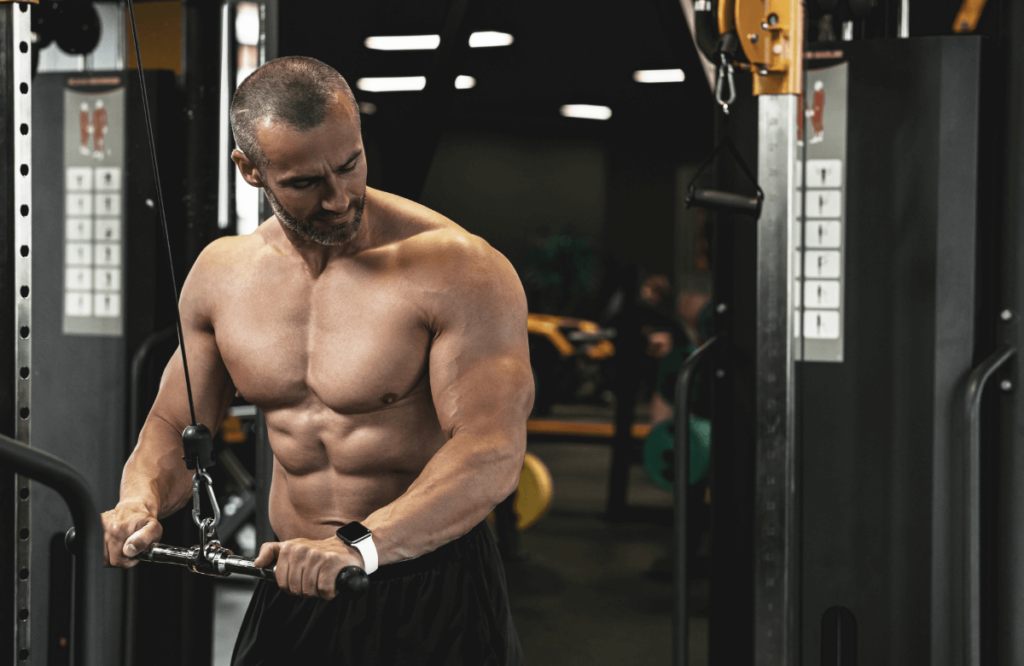Looking for a way to strengthen your arms? You might give the cable machine a try. A cable machine is a versatile piece of equipment designed to work multiple muscles. Using cable machine exercises, you can increase your arm strength without the need for racks of dumbbells or barbell weights.
Jump to:
- What Are Cable Arm Workouts?
- 6 Benefits of Doing Cable Arm Exercises Regularly
- Muscles Worked by Cable Arm Exercises
- Tips for Targeting Your Biceps with Cables
- Tips for Targeting Your Triceps with Cables
- 9 Cable Arm Exercises to Work Into Your Routine
- Cable Machines vs. Free Weights for Arms: Which Is Better?
What Are Cable Arm Workouts?
Cable arm workouts are done on a cable machine. They target your arm muscles with secondary muscles being worked throughout your body. Popular cable machine exercises might include cable bicep curls, cable rope curls, supine cable curls, split stance exercises, preacher curls, arm cable preacher curls, overhead cable extensions, cable tricep extensions, and more.
Today, we’ll show you the benefits of regular arm workouts done with the cable machine. Cable exercises can build strength and endurance in a safer, more effective way for beginners. It just takes one piece of equipment to help you get results.
6 Benefits of Doing Cable Arm Exercises Regularly
There are many reasons we recommend incorporating cable arm exercises into your training program. You don’t need heavy weights or tons of equipment to unleash your arm power. Let’s take a look at some of the biggest reasons we recommend doing cable arm workouts regularly.
1. Better Movement Stabilization
This machine offers a variety of workouts that target every muscle in your body. At the same time, you want a smooth and stable workout flow, which decreases the risk of injury.
With benches that incline and adjust to your height, different cable attachments, handles, and rope, you’ll have greater freedom of movement. At the same time, it offers stability that allows time under tension in a safe way. It can help prevent injury and still give you an effective workout.
It also offers continuous tension, meaning your muscles get the full effect of the workout.
2. Improved Range of Motion
Because you can adjust the weight, attachments, and cable location, you can have any range of motion you desire. As such, you can target an area more effectively with less stress on your joints because you’re not pushing or pulling against gravity.
Unlike other machines that can limit your range of motion while working out, the pulley allows you to adjust your grip for your comfort. And a cable crossover machine offers crossover workouts that target more muscles than regular workout machines. You can adjust your stance to include more reps for faster muscle gain.

3. Easy to Adapt to Your Needs
Whether you’re just starting to work out or you’re a pro, cable machines cater to all fitness levels thanks to its various settings. Cable machines offer an all-in-one strength training workout that includes both the upper and lower body.
You can adjust the weight as needed, starting at the lowest setting and working up as you build more muscle, strength, and endurance. The rope attachments let you target] different muscles.
4. Various Handles Available for Training
Another benefit of using the cable machine is all the different handles and attachments that come with the machine. Some, but not all handles you can use include curl bars, hand grips, row bars, and tricep row bars.
The cable pulley system also allows for single attachments if you want to focus on one side at a time. The variety means you can target specific muscles in a wider range of workouts while allowing either a pronated grip or a supinated grip for more variety.
So whether you’re working on biceps, pecs, or quads, this machine has got you covered.
5. Easier to Max Out
As you know, lifting is most effective when you reach failure, and the cable machine helps with that. It has a weight stack that makes adding weight easier without compromising safety. If the weight is too light to max out, you can add more weight in seconds by moving the weight peg.
The machine offers constant tension for muscle development. It’s easy to max out when you add the cable machine to your arm training regimen.
6. Safety–Especially for Beginners
Not only does the cable machine offer more variety, but it also allows you to max out your workout in a more safe and secure environment.
This is due to the pulley system built into the cable machine. You can complete the entire exercise with a steadier and more controlled release than you might have with free weights. It offers constant tension without risking dropping the bar.
Muscles Worked by Cable Arm Exercises
A cable machine offers a versatile range of exercises to target various muscles in the arms. Here are the main arm muscles you can work with a cable machine:
Biceps Brachii: The biceps brachii, commonly known as the biceps, are the muscles on the front of the upper arm. You can target the biceps with exercises like cable curls, hammer curls, and concentration curls using different cable machine attachments.

Triceps Brachii: The triceps brachii, or triceps, are the muscles on the back of the upper arm. Target the triceps with exercises such as triceps pushdowns, overhead triceps extensions, and triceps kickbacks using a cable machine.
Brachialis: The brachialis is a muscle located underneath the biceps. It plays a role in elbow flexion and can be targeted with exercises like reverse curls or hammer curls using a cable machine.
Brachioradialis: The brachioradialis is in the forearm. While it’s primarily responsible for forearm movement, you can indirectly target it with exercises such as reverse curls or hammer curls using a cable machine.
Forearm Muscles: You can also use the cable machine to work the muscles in the forearm, including the flexor and extensor muscles. Exercises like wrist curls and reverse wrist curls using a cable machine can help strengthen and develop these muscles.
Remember, the cable machine provides a wide range of exercises and attachments that allow you to target various muscles in the arms. It’s important to vary your exercises and target different muscle groups to ensure balanced arm development and overall strength.
Always use proper form and start with an appropriate weight for your fitness level to avoid injury and maximize the effectiveness of your workout.

Tips for Targeting Your Biceps with Cables
When targeting your biceps with cables it’s best to use a variety of attachments to work both the biceps brachii (long and short head) to get the best results. We suggest starting with the straight bar handle attachment and connecting it to the lower pulley.
If you’re a beginner, try a straight bar bicep cable curl. Start at a lower weight and work your way up until you feel enough resistance that it becomes difficult, but not impossible. Use an underhand grip with elbows close to the body, holding the straight bar at shoulder width.
You’ll do the move the same way you would do any biceps curl. Start in an extended position and slowly curl your arms up till your hands are at shoulder level while focusing on flexing your bicep. Once you’ve completed the curl, slowly move back to starting position with continued slow and controlled motions.
As you work your biceps, remember to keep your core tight and let your arms do the movement. Adjust your grip or the attachments as necessary to get the most out of each exercise.
Keep increasing your weights as time goes on to ensure you’re working your biceps until failure. But don’t increase too quickly to prevent injury.
You can also target one arm at a time when working the biceps with a standing one-arm cable routine. You can complete many single-arm exercises with a single pulley cable machine, including single-arm cable preacher curls, standing single-arm bicep cable curls, and more.

Tips for Targeting Your Triceps with Cables
If you want to succeed in working your triceps with cables, we want to give you a few pointers. Along with choosing the right attachments, minding your posture, and choosing the right weights, here are some things we recommend:
Make sure the cable height is correct for the exercise. You should be able to fully extend your arms without any restriction or impingement. Adjusting the cable to chest or shoulder height usually works for tricep exercises.
Activate your core muscles by pulling your belly button in towards your spine. This helps stabilize your body and maintain proper form while performing tricep exercises.
Don’t forget to focus on contracting the triceps muscles. When extending your arms during the exercise, concentrate on squeezing your triceps at the peak of the movement. This mind-muscle connection can help ensure that you are effectively engaging and targeting the triceps and not pulling on other muscles unnecessarily.
We love the cable machine because it’s easier to control the moves, but you still want to keep that in mind. Avoid using momentum or swinging your arms during the exercise. Slow and controlled movements will provide better engagement of the triceps and minimize the involvement of other muscles.
You can also try one-arm exercises like the single-arm overhead cable triceps extensions to better isolate the muscles as you work out. And don’t forget about other forms of triceps exercises that can boost your triceps muscles.

9 Cable Arm Exercises to Work Into Your Routine
There are many effective cable arm exercises you could add to your workout routine, and we hope you’ll try them all to find your favorites. For now, take a look at these arm exercises that can maximize your arm strength.
1. Cable Overhead Extension
One of the most popular ways to work your triceps using a cable machine is an overhead triceps extension. You’ll perform the exercise by using a straight cable bar, EZ bar, or rope attachment.
Start in a standing position and grab the cable attachment overhead. Lean forward to a 45-degree angle and stop. Then, move your arms forward over your head until your arms are straightened out. Keep your core tight and don’t move your body so your triceps do all the work.
2. Standing Cable Curls
To perform a standing cable curl, stand facing the cable machine with your feet shoulder-width apart. Adjust the cable pulley to the lowest position and attach a straight bar or handle. Grasp the bar or handle with an underhand grip with palms facing up. Keep your upper arms stationary and close to your sides.
Exhale and curl the bar or handle towards your shoulders by flexing your elbows. Squeeze your biceps at the top of the movement. Inhale and slowly lower the weight back to the starting position while maintaining control.
3. Cable Hammer Curls
For stronger biceps and forearms, try cable hammer curls using. You’ll face the cable machine with your feet shoulder-width apart and put the cable pulley with a rope attachment at the lowest position.
When you grab the rope handle, keep your grip neutral with your palms facing each other. Your arms should stay close to your sides.
To perform the movement, curl the rope handle towards your shoulders by flexing your elbows. Maintain a hammer-like grip throughout the movement. Squeeze your forearms and biceps at the top of the movement to keep them engaged.
Inhale and slowly lower the weight back to the starting position while maintaining control.
4. Cable Triceps Pressdowns
You’ll need a straight bar or rope handle attached to the high pulley of the cable machine to do cable triceps press-downs. You’ll also use an overhand grip and keep your upper arms close to your sides while you bend your elbows at 90 degrees.
Extend your forearms downward by straightening your elbows. Keep your core tight and maintain slow and steady movements. Squeeze your triceps at the bottom of the movement. Inhale and slowly return to the starting position.
5. Inclined Cable Curls
Inclined cable curls are a seated arm workout that requires an incline bench. Set the bench at a 45-degree angle and position the cable machine with the pulleys at the lowest setting. Attach a handle or rope to each side of the cable machine.
Sit on the incline bench and grab the handles or ropes with an underhand grip. Lean back on the bench with your arms fully extended and palms facing up.
Keeping your upper arms stationary, exhale and curl the handles or ropes towards your shoulders. Don’t let your wrists loosen up. Squeeze your biceps at the top of the movement. Slowly lower the handles or ropes back to the starting position.
6. Preacher Cable Curls
While you would usually perform preacher curls with a barbell or dumbells, you can use a cable machine too if you have a preacher curl pad. You’ll also need a straight bar attachment and the lowest pulley setting.
Position yourself in front of the cable machine and adjust the seat or bench to a height that allows your arms to rest comfortably on the preacher curl pad. Use an underhand grip and rest your arms on the pad.
Curl the bar towards your shoulders by flexing your elbows. Squeeze your biceps at the top of the movement. Keep your arms close to your side and maintain tension in your biceps head to get maximum effectiveness from the move.
7. Bayesian Cable Curls
Using the band handle attachment, adjust the cable pulley so it’s on the lowest setting.
Face away from the cable machine with a staggered stance, which will help keep you stable. Grab the handles in an underhand grip with the elbows close to the body and shoulders pulled back in a stable position. Slowly pull up in a controlled arc motion until the elbows are at a 45-degree angle. Slowly release back to the starting position.
8. Cable Kickbacks
Set up a cable machine with a low pulley and attach an ankle cuff to the cable. Facing the machine, put the ankle cuff on the leg you’re not working on.
Then, step forward with the leg you want to work, keeping a slight bend in the knee. Lean forward and place your opposite hand on a stable surface for support.
Extend your working leg backward, squeezing your glutes and hamstrings. Keep the leg straight with a slight bend in the knee. Pause briefly at the top of the movement. Slowly return your leg to the starting position, maintaining control from start to finish.
9. Reverse Grip Pushdown
Use a straight bar or rope handle and set the cable to a high pulley setting. Face the cable machine and grab the bar or handle with an underhand grip. Place your feet shoulder-width apart and slightly bend your knees.
Keep your upper arms close to your sides and your elbows bent at approximately 90 degrees. Push the bar or handle downward by extending your elbows, focusing on squeezing your triceps.
Pause briefly at the bottom of the movement, feeling the contraction in your triceps before slowly returning to the start.
Cable Machines vs. Free Weights for Arms: Which Is Better?
Free weights are and always will be a staple for new and expert bodybuilders. They work very effectively for muscle growth and development, but they can put excess strain on the joints. The risk for injury may be higher with free weights too.
To switch up your routine, you might want to incorporate cable exercises now and again. Almost any workout you do with free weights can be done on a cable machine too.
We also love that the cable machine has few limits in accommodating your personal body size and shape. And it takes up less space than free weights, which can be beneficial in a home gym setting.
But a cable machine can’t replace free weights. There are limitations to what you can do with a cable machine, including max weights. As you progress in your lifting journey, you’ll want to incorporate exercises using both free weights and a cable machine for maximum effectiveness.














